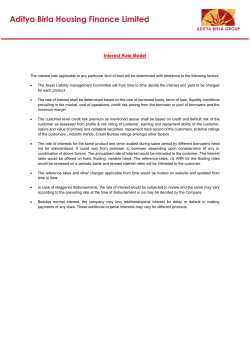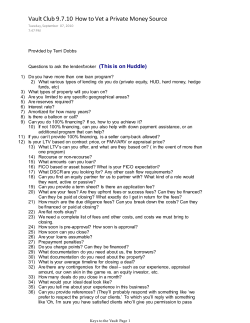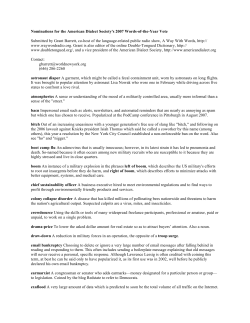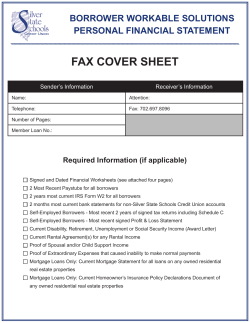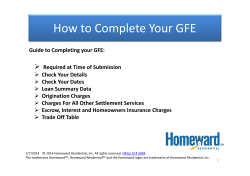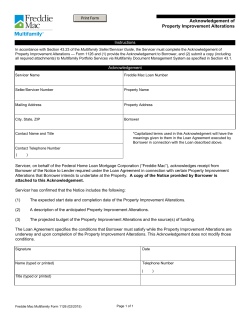
Conforming Product Profile
Conforming Product Profile Please refer to full product parameters. Subject to Change. FANNIE LTV’S LTV CLTV HTLTV FREDDIE LTV’S CREDIT SCORE PRIMARY 1 UNIT PURCHASE 1ST TIME HOME BUYER 97% N/A N/A 640 PRIMARY 1 UNIT RATE/TERM EXISTING FANNIE 97% 97 97 640 PRIMARY 1 UNIT PURCHASE 95% 95 95 620 PRIMARY 1 UNIT RATE TERM 95% 95 95 620 PRIMARY 1 UNIT CASH OUT >75% - 80% 80 80 640 <75% 80 80 620 PRIMARY 2 UNIT PURCHASE RATE/TERM >75% - 85% 85 85 660 >70% - 75% 80 80 640 <70% 75 75 620 PRIMARY 3-4 UNIT PURCHASE / RATE TERM > 65% - 75% 75 75 640 <65% 75 75 620 PRIMARY 2-4 UNIT CASH OUT >65% -75% 75 75 660 <65% 75 75 640 2ND HOME PURCHASE / RATE TERM >80% - 90% 90 90 660 >65- 80% 90 90 640 <65 80 80 620 2ND HOME CASH OUT >55% - 75% 75 75 660 < 55% 75 75 640 < 55% N/A N/A 620 NOO 1-2 UNIT PURCHASE 1 Unit 85% 85 85 720 1 Unit 80% 80 80 660 2 Units75% 75 75 660 1&2 Units <55% 75 75 620 NOO 1-2 UNIT RATE/TERM > 55% - 75% 75 75 660 <55/% 75 75 620 NOO 1 UNIT CASH OUT >55% -75% 75 75 680 < 55% 75 75 620 NOO 2 UNIT CASH OUT >55% -70% 70 70 680 <55% 70 70 620 NOO 3-4 UNIT PURCHASE / RATE TERM >55% - 75% <55% 75 75 75 75 680 620 Intended for mortgage professionals only. Not an advertisement. Subject to change. 1st LTV without SECONDARY FINANCING 97% 1ST LTV with CLTV HTLTV SECONDARY FINANCING PRIMARY 1 UNIT PURCHASE N/A N/A N/A CREDIT SCORE 640 97% only available on Home Possible Advantage (see guidelines) 95% 90 95 95 PRIMARY 1 UNIT RATE TERM 95% 90 95 95 PRIMARY 1 UNIT CASH OUT >75% - 80% 75 80 80 <75% 70 80 80 PRIMARY 2-4 UNIT PURCHASE-RATE/TERM >75% - 80% 75 80 80 >70% - 75% 75 80 80 <70% 65 80 80 PRIMARY 2-4 UNIT CASH OUT 70 75 75 65 75 75 2ND HOME PURCHASE / RATE TERM >80% - 85% 80 85 85 >70%-80% 80 80 80 <70% 70 70 70 2ND HOME CASH OUT >70% - 75% 70 75 75 >55% - 70% 70 75 75 < 55% 55 75 75 < 55% NA N/A N/A NOO 1 UNIT PURCHASE 85% 80 85 85 80% 80 85 85 NOO 1 UNIT RATE TERM >55% - 75% 70 75 75 <55% N/A N/A N/A NOO 1-2 UNIT CASH OUT 1Unit >70% -75% 70 75 75 2Units < 70% 65 75 75 1&2 Units <55% 55 75 75 NOO 2-4 UNIT PURCHASE / RATE TERM >55% - 75% 70 75 75 <55% N/A N/A N/A >65% - 75% <65% 620 620 640 620 660 640 620 660 640 660 640 620 660 660 640 620 720 660 660 620 680 680 620 680 620 FANNIE / FREDDIE MAX LOAN AMOUNTS UNITS MAX LOAN AMOUNT 1 $417,000 2 $533,850 3 $645,300 4 $801,950 Larger loan amounts may apply in OFHEO high cost areas, check with AE for details. Page 1 of 6 4/21/2015 Conforming Product Profile Please refer to full product parameters. Subject to Change. *All loans must be approved through AUS. Max debt ratio 50% for LTVs up to 95%. Approval is always subject to acceptable mortgage insurance coverage. For specific guidelines relating to: FANNIE MAE: 5-10 FINANCED PROPERTIES – (Used when the subject Property is an Investment Property or 2nd Home) MISCELLANEOUS For Owner Occupied properties Crescent will restrict the number of 1-4 unit financed properties to a maximum of 10. For Second and Investor loans: For LP loans a borrower cannot have more than 4 financed properties including primary. For DU loans – may allow 5-10 financed properties – see link above. Crescent may allow multiple loans to a borrower to 2 on a case-by-case. Crescent will require a Net Tangible Benefit form to be completed on all Refinance Transactions (state specific forms as required). The borrower benefit requirement can be met in four different ways based on changes in the terms between the existing loan and the new loan. o Reduction in the monthly principal & interest pmt o Reduction in the interest rate o Reduction in the amortization term o Movement to a more stable product Cash Out Refinances: Borrower must have owned property for 6 months prior to new note date. If borrower has been on title at least 6 months, but cannot demonstrate an acceptable continuity of obligation, the loan is considered a cash out and LTV is limited to 50% of current value. Delayed Financing Exception – Fannie Mae Only: Borrowers who purchased the subject property within the past six months are eligible for a cash-out refinance if all of 1 the following requirements are met: The new loan amount can be no more than the actual documented amount of the borrower’s initial investment in purchasing the property plus the financing of closing costs, prepaid fees, and points (subject to the maximum LTV/CLTV/HCLTV ratios for 2 the transaction). The Purchase transaction was an arms3 length transaction. The transaction is documented by the HUD-1, which confirms that no mortgage financing was 4 used to obtain the subject property. The sources of funds for the purchase transaction are documented (such as, bank statements, personal loan documents, HELOC on another property). 5 All other cash-out refinance eligibility requirements are met and cash-out pricing is applied. Note – The preliminary title search or report must not reflect any existing liens on the subject property. If the source of funds to acquire the property was an unsecured loan or HELOC (secured by another property), the new HUD-1 must reflect that source being paid off with the proceeds of the new refinance transaction. Rate / Term refinances: 4 months ownership seasoning is required for Freddie Mac. Crescent will consider shorter timeframes for Fannie Mae as appropriate. (Unallowable refinance is when someone closes an interim loan in order to skirt agency guidelines, with the intent to refinance quickly). On a rate a term refi, borrower can payoff existing 1st lien, secondary financing that was used to purchase the property (as evidenced by a HUD 1), closing costs, prepaids, and cash to the borrower not to exceed lesser of 2% or $2000. Refinances on homes listed for sale: Limited Cash Out: no specific time frame, but home must have been taken off the market PRIOR to the date of application for this loan. Value must be supported. If property was taken off the market within 30 days prior to application, we will also require an acceptable letter of explanation from the borrower as well as a statement that they do not intend to relist the property post closing. Cash Out: If property listed for sale in 6 months preceding application, max LTV 70% Important – PMI Certs will be ordered on construction 2-time loans just prior to closing and subject to MI restrictions at that time. Manufactured Homes: Not acceptable Modular Homes: (Off Frame) Acceptable providing comps are similar. Condominium: Established project only. Primary, Second Home. No Investment. All units and amenities are 100 percent complete, no more than 10 percent owned by developer. Refer to parameters. No condotels. For DU: “Spot limited” only for established projects. Must meet FNMA guides. May limit # of units Crescent will finance in a project. Targeted projects with specific marketing efforts, or if lender is named as preferred lender by the developer or HOA, project will not be eligible. No condotels. Intended for mortgage professionals only. Not an advertisement. Subject to change. FNMA-5-10 Financed Properties.doc Converting Primary to a Second Home When a borrower is purchasing a new primary residence and converting his current residence to a 2nd home, we will count both payments. See reserve requirements under “assets.” LP/DU-Primary Residence Converted to Investment Property - when converting to investment property and borrower purchasing new primary residence. If LTV/TLTV/HTLTV for current primary residence is greater than 70%, rental income can’t be used to qualify. Both payments (current & new) must be included in the payment to income ratio. If LTV/TLTV/HTLTV for current primary residence is less than 70% (as evidenced by a 2055 exterior only inspection dated within 60 days of the new Note), rental income may be used provided we have a fully executed lease and a receipt of a security deposit from tenant and evidence of the deposit into borrower’s account. If this can’t be documented then both mortgage payments will be used in qualifying. New construction-appraisal must be within 120 days of Note and input in AU should reflect new construction – not refinance. If over 120 days, 1004D required. Data Integrity in DU/LP system must match documents in file, regardless of feedback message i.e. income, assets, etc. DU Approve Eligible/LP Accept findings only, no cautions available. Standard Monthly MI for LTV’s >80%. For LPMI refer to parameters. All Texas Refis - must comply with 50 (a) (6) & any owner-occupied refinance that falls under this regulation will be limited to 80% LTV, primary residence, single family unit. For LP loans, a refinance is “paying off “existing mortgage with the cancellation of the existing promissory Note and a new Note is executed by the same borrower or a previously owned free and clear by the same borrower. Verbal VOE’s – 10 business days prior to closing. New Construction – 1x and 2x Close and Renovation refer to 1x Close Option I; 1x Close Option II; 2x Close Fannie; 2x Close Freddie. Page 2 of 6 4/21/2015 Conforming Product Profile Please refer to full product parameters. Subject to Change. MISCELLANEOUS (continued) Currently Crescent does not close loans in Name of Trust or LLC. Community seconds are not acceptable on purchase transactions or for re-subordination on refinances. OCCUPANCY LTV/CLTV RATIO MAXIMUM INTERESTED PARTY CONTRIBUTION Principal Residence Greater than 90% 3% Principal Residence or Second Home 75.01%-90% 6% 75% or less 9% Investment Property All CLTV Ratios 2% Minimum loan amount for NOO properties is $50,000. As a rule, Crescent does not close loans for improvements located on “leased land.” Borrowers Primary Residence – Pending Sale (will not close prior to our closing). Must count both payments in DTI. Leases on Subject Property – If the subject property is used for investment, or is a 2-4 unit property, any and all leases existing on the subject property must be provided at the time of underwriting. The DU message will require that the lease “does not contain any provisions that could affect Fannie Mae’s first lien position on the property “ (i.e. lease purchase, contract for deed, etc.). If there are no existing leases then the borrower must certify to this in writing. INCOME A signed 4506T is required for all borrowers prior to closing & income will be verified prior to closing through the IRS. This must be completed by Crescent. Self-Employed Income: Income analysis form #91 (Freddie) or a similar one will be required for all self-employed and commission income & must be in the file for underwriting. When a borrower is self-employed, tax returns will be required regardless of whether or not the income is used to qualify to determine the impact of a business loss. When the loan is input in the automated system, if the borrower owns a business (even part-time) you must indicate self-employed even if the income from selfemployment is not being used to qualify. Length of self-employment to be determined per AU findings. Document income per AU findings. If the tax returns reflect a significant increase or decrease in income, additional documentation must be supplied to support the income is stable and likely to continue for the next 3 yrs. This may be additional yrs tax returns, etc. Additional income the borrower draws through his corporation, partnership or S Corporation cannot be used for qualifying if personal returns do not show a history. There must also be a reasonable expectation that the income will continue. Verification of the borrower’s business existence must be verified from 3rd party sources include, but are not limited to, a regulatory agency, phone directory, internet, directory assistance, licensing bureau, etc. This function will be done by Crescent. Commission Income – Generally 2 years commission is needed to obtain AU approval. Document per AU findings. Employee paid expenses must be deducted from borrower’s gross commission income. Income calculations will be based on agency guides & could fluctuate based on frequency of receipt. Intended for mortgage professionals only. Not an advertisement. Subject to change. Other Income: A 2-yr history of employment/income will be reviewed. A written note must be in the file either on the transmittal or a separate attachment reflecting how income used to qualify the borrower was calculated. For overtime, hourly, part-time income, etc. this can be from the processor to reflect income used to input in LP/DU. The income/employment must be stable & likely to continue for at least the next 3 yrs. Income received for less than 2 yrs is generally not acceptable , but will be reviewed on a case-by-case basis & may require additional documentation. When grossing up tax exempt income to qualify, documentation such as tax returns must be in the file to support the income that is not taxable. If documentation is not available, the tax exempt income cannot be grossed up. Freddie Mac: Income from alimony, child support or separate maintenance requires documentation showing that the payer was obligated for payments for the most recent 12 mos. & payments will continue for the next 3 yrs. Document per AU findings. If payer was obligated for less than 12 mos., but not less than 6 mos., income used to qualify may be considered if the amount of the monthly payment does not exceed 30% of the borrower’s qualifying monthly income. Fannie Mae: Provide documentation per the DU findings for alimony, child support or separate maintenance income. When the 1003 reflects a borrower is separated, the underwriter will request the written agreement (if applicable) to establish the borrower’s financial position. If a separation agreement is not applicable, the underwriter may ask for an affidavit from borrower to determine if there are any obligations that may be a potential risk. Housing/parsonage allowance, royalty income & notes receivable must have been received for 12 mos. & will continue for 3 yrs. Capital gains, public assistance income, foster care income & dividend & interest income must have been received for most recent 2 yrs & will continue for 3 yrs at same level as income used to qualify. Trust income must continue for at least the next 3 years (but no history is required). Significant increases or decreases in income must be carefully analyzed. All income used to qualify must be documented to be stable & anticipated to continue for the foreseeable future. Page 3 of 6 4/21/2015 Conforming Product Profile Please refer to full product parameters. Subject to Change. INCOME (continued) Examples: 1. Borrower received a one-time incentive payment that brought their earnings up from previous earnings. 2. Borrower had an injury that prevented him from working or earning income but back on job (previous earnings may be lower). For a newly employed borrower that has less than 2 yrs. Employment & income history, income may be used to qualify if documentation is in file to support the borrower was either in school or in a training program immediately prior to the current employment history. Borrowers who are re-entering the workforce & have less than 2 yrs. employment/income history, the income may be used if the borrower has been at current employer for a minimum of 6 mos. & we document borrower had previous employment in the same field. Borrowers will need to document the reason they have not been employed during the last 2 yrs. Rental Income: This income will be determined by actual cash flow from Schedule E. Reserves must be documented per AU findings. If Schedule E does not reflect rental property because the property was acquired after that tax yr, form 998 (operating income statement) may be used if the rental income is from the subject or a signed lease for other REO may be used (75% of the gross rental income less PITI is used for qualification). Rental income generated from borrower’s 2nd home may not be used to qualify. Automobile Allowance: Must have a 2 yr. consecutive history of receiving it & evidence the allowance will continue for 3 more yrs. The full amount of the allowance may be added to the borrower’s income & the full amount of the lease or financing amount is added to the monthly obligations. Any associated business expenditures must be calculated in the borrower’s debt-to-income ratio. When in putting a loan in LP or DU, if a borrower will be on the loan, but not using their income to qualify & they are selfemployed or have a small company on the side in addition to a full time job, you must still input the borrower as selfemployed. LP only - purchase single family, primary residence, for future employment – to use as effective income, you must provide a signed offer letter by all parties. This offer letter must be non-contingent. The time frame between the Mortgage Note date and the start of employment must not exceed 90 days. Borrower must have adequate cash reserves after the Note date to pay the monthly principal & interest, taxes & insurance during the 3-mo. employment gap plus 3 additional mos (6 mos). A verbal VOE for the current employment within 10 business days of the Note date must be obtained by Crescent. LTV’s > 80% are subject to MI Guides. ASSETS A gift letter, signed by the donor, will be required regardless of the AU findings. Retirement Accounts: Can be used for closing requirements or considered as reserves under certain circumstances. You must use the borrower’s vested balance in the account & subtract any outstanding loans that are secured by the account. Then 60% of the remaining balance can be considered for U/W . Crescent will require proof of liquidation of funds from stocks, bonds & retirement accounts when using for closing or down payment. Document source of funds for large deposits in any account. Document source of funds for earnest money. If a self-employed borrower is using funds from a business account for closing, we will require a letter from his/her accountant confirming that the borrower has unrestricted access to the funds & that the withdrawal of the funds will not have a detrimental effect on the business. The accountant cannot be an interested party to the transaction and cannot be related to the borrower. Reserves: DU will calculate the reserve requirement for the subject property. When a borrower has multiple financed properties and is financing (or refinancing) a second home or investment property, DU is not able to determine the exact number of financed properties the borrower owns. As a result, the lender must manually apply the applicable additional reserve requirements for the other financed investment property and second home transactions. DU is also not able to determine if the borrower has not sold or has converted his or her principal residence to a second home or investment property. The lender must manually apply the applicable additional reserve requirements for the borrower’s current principal residence. NOTE: DU Refi Plus mortgage loans are exempt from the minimum reserve requirements. (see next page for reserve requirements) Intended for mortgage professionals only. Not an advertisement. Subject to change. Page 4 of 6 4/21/2015 Conforming Product Profile Please refer to full product parameters. Subject to Change. ASSETS (continued) Reserves (continued) Minimum reserve requirements: The minimum reserve requirements are described below. Principal residence For a mortgage loan secured by the borrower’s principal residence the minimum reserve requirements are determined by DU except: If the borrower’s current principal residence is pending sale or converting to a second home or investment property, the following additional reserve requirements (PITIA) must be calculated and documented (over and above reserves required by DU). If the percentage equity in Then additional reserves the current principal are… residence is… 2 months on subject property 30% or more AND 2 months on current principal residence 6 months on subject property Less than 30% AND 6 months on current principal residence Second Home or Investment Property For a mortgage loan secured by a second home or investment property, the minimum reserve requirements for the subject property are determined by DU. If the borrower owns other financed properties, the following additional reserves must be calculated and documented. The required reserves for a financed property are based on the qualifying payment amount of the financed property. If the total number of Then additional reserves financed properties is… are… 1 to 4 financed properties 2 months for each second home or investment property 5-10 financed properties 6 months for each second home or investment property CREDIT All revolving debt less than 10 mos. will be included in DTI. If the payment is not on the credit report & cannot be verified, 5% of the outstanding balance must be used to qualify. Crescent will include any installment debts less than 10 mos. that could impact the borrower’s ability to pay his mortgage payments in the debt ratio unless 6 mos. reserves can be documented to offset that payment regardless of the AU findings. This includes car payments, car leases, etc. Inquiries on the credit report generally reflect the borrower’s request for new or additional credit. Inquiries within the last 120 days must be addressed by creditor or a signed statement from the borrower & carefully reviewed when underwriting the loan. Any material discrepancy from the initial application & information in the credit report must be explained with a written statement in the file from the underwriter. Any mortgage debt not shown on the credit report must be verified. For all conventional LTV’s, Crescent will require 3 trade lines of credit history or, at a minimum, one trade line that is a large installment debt or a mortgage debt with a 12 month history. For LTV’s > 80% MI rules will also apply. The borrower must have sufficient credit history to reflect their ability to maintain payments in a timely manner. Verbal VOE’s will be performed by Crescent on all loans within 10 days prior to closing. Crescent to document source of the information. Cannot use source supplied by broker/correspondent/borrower. Age of Credit Docs – 120 days. Debts with secured assets – may not count in debt ratio as long as the loan is secured by the financial asset & was made by a financial institution. Assets that exceed the loan balance available to borrower may be considered. Installment debt with deferred payment – must be included in debt ratio calculation. Contingent Liability – to disregard this liability, you must have evidence showing debt is also in the name of the person making the payments. Satisfactory evidence that person is making the payments as scheduled and without assistance from the borrower is also required. 12 months history required. Crescent will comply with agency guides to insure good quality loans are being made. These steps include: checking social security numbers, verifying identity, validation of qualified parties to the transaction & determine if the borrower acquired any additional undisclosed debt prior to closing. Intended for mortgage professionals only. Not an advertisement. Subject to change. Prior to the loan closing, Crescent will use a 3rd party vendor who will “refresh” the borrowers’ liabilities. This will not have any impact on the borrowers’ credit score. If the “refresh” reflects debts that could impair the initial underwriting decision, the loan will be required to go back to the underwriter for review. If the “refresh” does not reflect additional liabilities, the loan will proceed through the closing process. It is very important you counsel the borrowers at the time of the initial loan application to encourage all liabilities be disclosed & for them not to incur any additional liabilities prior to closing. For Correspondent Customers who have the ability to draw their own closing documents, Crescent is the underwriter, it is imperative a “refresh” be done by Crescent prior to your closing. The underwriter will note this as a prior to closing condition and you must inform Crescent of your anticipated closing date so that we may “refresh” credit prior to closing. Failure to inform Crescent may result in a nonpurchasable loan. Crescent does not do manual underwrites – all loans must have LP “Accept” or DU “Approve Eligible;” however, a full underwrite is required as the automated system is only a tool to be used in underwriting the file. Any previous bankruptcy/foreclosure risk must have been evaluated when run through the automated system. Non-Traditional credit not acceptable. A borrower who has been late on mortgage payments in the last 12 months & displays a poor credit history risk could be denied regardless of AU findings. Crescent will consider loan requests from borrowers with prior foreclosures, bankruptcies, short sale transactions or deeds in lieu of foreclosure subject to the following guidance. In all cases approve/eligible findings are required. Foreclosures require 7 year waiting period Bankruptcy Ch 7 or 11, require 4 years Bankruptcy Ch 13 -2 years if discharged, 4 years if dismissed. Mortgage debts discharged through bankruptcy are held to the bankruptcy waiting periods and not the foreclosure waiting period. This applies even if a foreclosure action is subsequently completed. Pre-foreclosure sales, short sales and deeds in lieu of foreclosure require a 4 year waiting period calculated from the date of the prior sale or deed in lieu to the disbursement date on the new loan. Charge offs of mortgage debt require a 4 year waiting period. Page 5 of 6 4/21/2015 Conforming Product Profile Please refer to full product parameters. Subject to Change. APPRAISAL Loans run through DU that receive an excessive value warning or loans run through LP that have an HVE factor greater than 20% will result in at least one of the following: 2nd review by an Underwriting Manager. Desk Review/Field Review Rejection of the appraisal if it is unacceptable. The feedback message may be received on any new loan input in LP & on resubmissions. The HVE is an estimate & you will more than likely see a difference between the HVE & the appraised value; however, if Y5 or Y6 is in the feedback message, this may be an indication the value and/or purchase price may be excessive. IMPORTANT – THE HVE POINT VALUE ESTIMATE SHOULD NOT BE SHARED WITH THE APPRAISER & SHOULD BE TREATED AS CONFIDENTIAL AS YOU MUST STILL COMPLY WITH THE APPRAISER INDEPENDENCE POLICY. LP-HVE Value Estimates Memo dated 3-10-10 Resubmissions – Please keep in mind, it is very important to input correct information when running LP/DU as each resubmission is subject to being updated. This can be very critical - the closer you get to closing & re-doing the GFE, another appraisal may be required. Agency databases are updated regularly. All appraisal requests will be placed through Crescent with exception of a Correspondent Customer who closes in their name and the Correspondent’s policies & procedures have been approved by Crescent Appraisal Department. The Correspondent will provide a Certification with each appraisal they have complied with Appraisal Independence requirements. Intended for mortgage professionals only. Not an advertisement. Subject to change. Page 6 of 6 4/21/2015
© Copyright 2025
